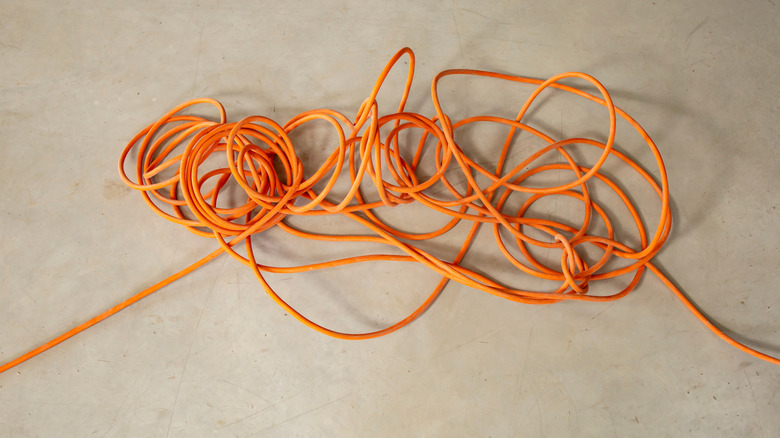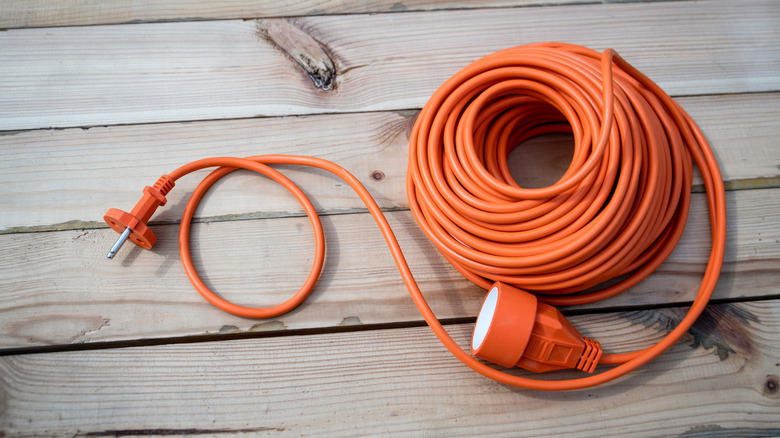The Best Way To Store & Organize Extension Cords Without The Tangled Mess
If you had to create a tournament bracket for the most irritating yet mundane parts of any DIY project, the Great Untangle — that is, the process of untangling the endless knots and tangled loops of your extension cord — would definitely make it within the sweet sixteen, if not the top five. Even if you carefully wind it up every time you're done with it, it feels inevitable that the next occasion will see it magically become re-tangled, looking much as if your kids tried to use it to practice making knotted friendship bracelets (and not very successfully).
How is this possible, and how can you fix it? Fortunately, there is a simple solution for winding your cords that has been used by professionals in the audio-visual industry for ages.
Before I became an interior designer, my first college degree was in television production, and I spent the better part of a nearly a decade coiling and uncoiling audio XLR cables and various types of extension cords on production shoots. In fact, as a part of our production 101 final exam, the students actually had to successfully complete a cord coiling relay race under the time limit, where each classmate had to properly coil an audio cable and then pass it to the next person, who had to toss it quickly open to uncoil and begin the rewinding process for themselves, no tangles or kinks allowed. We knocked it out of the park, and that's because we used a special wrapping technique called "over-under" that ensured the cables would stay untangled and free of the damage caused by kinks. Lucky for you, I am here to share tips from my production days so your extension cord coiling and storage can look as neat and professional as a television shoot (or very niche relay race).
How to coil your extension cords with the over-under method
So how do you perform the over-under coiling technique? While I'll break it down step-by-step, I highly recommend watching a video demonstration (like the one above from This Old House) to visualize the method in action. Begin by holding one end of the cord in your non-dominant hand with the plug facing away from you. This hand will be the holder while the dominant hand will be the coiler.
Make your first typical "over" loop with your dominant hand, rolling the cable forward between your fingers (pushing the fingertips away from you over the top of the cord) as you are looping, to encourage the natural coil. For the second loop, use your dominant hand fingers to roll the cord back the opposite way by pushing your thumb under the cable and away from you to encourage a loop that goes the reverse direction. It will naturally create a coil that wraps underneath itself (thus the "under" designation), with the bottom of the loop flopping over your wrist as it forms. Allow the natural coil direction to guide your arm up underneath the loop toward your non-dominant hand for placement. Repeat this process, alternating over and under loops until the cable is fully coiled. When complete, use a string or velcro strip to secure the coil, or simply plug the two connector ends into each other to complete the circle.
Here's the fun part: when you're ready to use the cord again, hold one end and give the rest of the coil a solid toss forward. The over-under method will allow the cord to quickly extend, tangle-free, as well as lay flat on the ground when in use. Amazing, but why does this method work so well?
Why winding your cables with the over-under method works
Let's dig into a little cord knowledge so you can impress your dad the next time he starts winding an extension cord around his palm and elbow like a maniac (I think they teach you that technique in dad school so they can pass it down, ensuring tangled cords for the next generation). Extension cords have many parts that work together. Within the visible outer sheathing there are typically three insulating covers, which each contain either a solid conducting electrical wire or a set of thin wire fibers that are twisted or braided together.
When you use the dad method of looping your extension cord the same way over and over, you are continually twisting the cord's many components, creating tension on all parts and friction between them. Over time, this pressure and wear causes kinks and cord damage. The twisted kinks cause tangles, knots, and bulk, which eventually prevents the cord from laying flat.
By using the over-under method of coiling, the double loop technique neutralizes both the twist and the tension by reversing the direction every other coil. This keeps the cord's complicated interior structure free of pressure, friction, and therefore damage, prolonging the life of the cord. The neutralized twist is also the reason that fun little tangle-free extension toss works so well and allows the cable to lay flat. Even though it takes a little practice to get the hang of, the learning curve of the over-under technique is worth it to save you time and money in the long run. So, take my production assistant tips and go teach your dad some new cord winding tricks. Maybe even stage your own coiling race... dads love that kind of thing!

